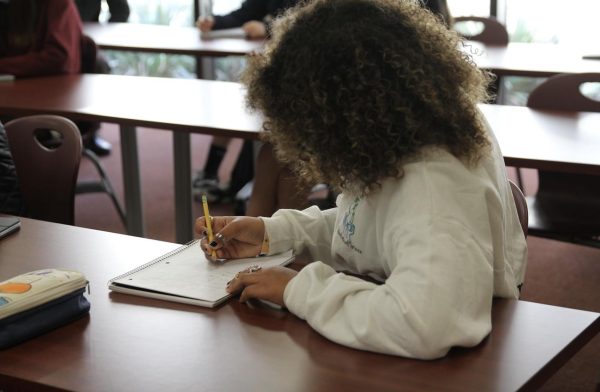“What grade did you get on that test?”
“Isn’t she supposed to be a hard grader?”
It’s difficult to go more than a day at Bishop’s without having or overhearing some sort of conversation about grades. Despite how frequent these discussions are, most students don’t have a great understanding of teachers’ grading processes—for instance, how teachers decide what assessments to give or how they work to keep grade consistency among classes. This often leads to a disconnect between those giving the grades and those receiving them.
So, how exactly do teachers determine grades, and what do students think about it?
History — Department Head Ms. Karri Woods
Isabella “Bella” Combs (‘25) characterized history as a “half and half” subject in terms of objectivity (English being more subjective and math being more objective), particularly in terms of writing assignments. She finds history essays to have clearer guidelines than English; but mentioned “it really depends on who you have as a teacher. You kind of [have to] figure out what style works best [for them], [so] sometimes it can be a little tricky.”
According to Ms. Woods, essays—among other assessments—have a standardized, predetermined value before the year starts. “A [teaching] team may determine that major assessments, including essays and tests, account for 60% of the semester grade for all students in that course,” she explained. They may also predetermine the percentage value of a specific assignment, like an essay.
Ms. Woods added that the “features and weight” of assessments are “nearly identical” across all elective classes, including a drafted analytical essay and research paper at set intervals during the year. Elective teachers also meet as a team at least once a semester to grade sample essays from each other’s electives “in order to calibrate expectations and ensure we’re offering similar feedback to our students,” she added. They also “read and discuss sample essays together.”

Audrey Lin (‘25), who took Global Cold War last semester, explained that her first quarter essay was a shorter paper with a set prompt that “used sources that we had already read in class.” Carley Chen (‘25), who took Ancient Empires, said that her paper was also a short assignment with provided sources and set prompts, though she mentioned that her teacher “split us into pairs, so we each had a different topic” for the essay.
Besides essays, most students find history test grades—particularly multiple choice—easier to understand because “there is only one right answer,” as Amelie François (‘26) explained.
Overall in terms of grades, Ms. Woods said that the department wants “to offer our students an honest assessment of their mastery of course content and critical thinking skills” and “ensure that [students] will have opportunities to continue refining those skills in subsequent history courses.”
English – Department Head Dr. Anna Clark
According to Dr. Clark, the first step in assessing English students is setting class-specific and departmental benchmarks. “[Teachers] typically try to articulate the meaning of grades on a rubric, a course description, or an assignment description,” she explained. “When we actually go to evaluate students’ discussion performance, writing, and reading comprehension, we weigh the work that we’re seeing there against the benchmarks that we’ve established.” Many English teachers often meet to compare work to ensure fair evaluation by these benchmarks.
Students respond differently to this kind of “benchmark” assessment, which often manifests in rubrics. For Grace Dabir (‘24), “anything relating to does not meet, meets, or exceeds expectations” can be difficult to understand, because she finds grading without numbers or percentages less transparent. Conversely, Eleanor Meyer (‘26) prefers rubrics, because she “knows what to target” to improve her writing. Grace added that most teachers are transparent when you ask them about your grade.
To keep consistency, Dr. Clark explained that she will “look over all assignments from a class to get a sense of the range” before she starts grading. “This helps to ensure that I grade all the assignments fairly, without letting grading fatigue bias me in one way or the other, and it allows me to identify exemplars that help me make my assessments,” she added.
Though she finds it to be clearer this year, Bella has struggled with English grading in the past because “it’s really subjective”—though she acknowledged that “it’s hard not to be subjective while reading [essays].”
However, Dr. Clark noted, “While it might seem as though evaluating something like the originality of a thesis statement is kind of subjective, a teacher’s expertise in their field and in the range of students’ work … makes that determination more straightforward than you might think.” She added that English teachers typically feel similarly when comparing grades.
“We want to do justice to our students’ work,” Dr. Clark said, “and to honor the trust that they’re putting [in] us.”
Science — Department Head Ms. Laura Cummings
According to Ms. Cummings, science assesses “concrete skills…[and] metacognitive habits of mind that help you develop a hypothesis and support a claim with evidence.” She frames this in terms of Bloom’s taxonomy, a scale characterizing levels of understanding: the lower levels are “remembering and understanding,” which build up to “applying, analyzing, evaluating, and creating” as students mature, she explained.

Like other department heads, Ms. Cummings emphasized consistency and collaboration among teachers. “While teachers might not sit next to each other while they’re grading every paper, they might look at a couple sample responses and say, ‘Okay, ‘What’s strong about this? Where are the misconceptions? What would be our ideal response? How can we scale our standard from there?’”
This analysis gets even more specific. “We’ll look at our regular distribution of As and Bs to Cs, and [if] there’s a significant difference for one [teacher], we need to look at a more granular level,” she explained. This means analyzing the specific assessments causing grade disparity and finding solutions to eliminate the disproportion.
Many students prefer grading in STEM because they find it simpler. “The objective types of grading are the easiest to understand,” Grace said.
Nevertheless, one issue Bella has with science, despite its objectivity, is that the closed gradebook she has in biology class can make it hard for her to understand where she is garde-wise. “It’s nice to see, ‘Oh, I have a test coming up, how much do I need [to study]?’ [So] I can compensate for how much time I need to spend on specific subjects,” she explained.
Though Ms. Cummings understands the importance of grades, she hopes “students are looking not just at that letter, but more holistically at all the forms of feedback that they’ve received,” because as she put it, “grades collapse a whole year’s worth of learning and understanding and testing and applying into one letter.”
Math — Department Head Mrs. Catherine Beamer
Math grades in eighth grade and upper school are calculated using numerical values, though “some teachers choose to use total points to calculate overall grades, while others have a semester grade broken into percentages of each component,” explained Mrs. Beamer. For sixth and seventh grade where letter grades aren’t used, students generally receive a point value on assessments. On report cards, their progress is categorized as Emerging, Developing, Skilled, or Exemplary for both “work habits and content understanding.”
Students in eighth grade and upper school generally favor math’s numerical grading. “I feel like the sciences [and] the mathematics, those are always very clear cut,” Bella said. Similarly, Amelie prefers grades in “subjects that are less abstract and more concrete.”
However, Eleanor expressed that sometimes the numerical grading can be less helpful. “Teachers will mark where I went wrong [on a problem] but won’t always explain why it’s wrong or leave a comment on what was the right method, so I can learn from my mistake,” she said.

Mrs. Beamer also expressed the importance of consistency across classes. Teachers meet to discuss class performance and expectations, so that despite some variance in teaching style, “the overall experience in the course [is] similar,” she said. Math also keeps grading fair by constantly re-evaluating students. Things like retakes, test corrections, and projects “are all more recent additions” to assessments, Mrs. Beamer mentioned.
Changes in math over the years, including new technology, also affect grading. As Mrs. Beamer explained, “It is no longer just pencil and paper, but also Desmos, graphing calculators, and other tools.”
Overall, Mrs. Beamer acknowledges that it can feel like “a number doesn’t always represent a student’s understanding of the material,” but nevertheless sees grades as “a concrete way of communicating where a student is” despite its imperfections.
World Languages — Department Head Mr. Ian Hayden
Assessment in the World Language Department is unique in that it isn’t comparative, but rather “based on [students’] individual work with respect to a certain set of learning goals within that language,” Mr. Hayden explained. Languages “come to people at different times, at different rates, in different ways,” he said. “So how do you grade that?”
Consequently, the language department aims to grade based on controllable objectives that are related to the language proficiency goals and other learning outcomes of the course. “If [I] get a B plus, [I] should know exactly why, how that grade represents my work …and how I can improve,” Mr. Hayden explained.
Bella appreciates this clarity. Her writing assignments in Spanish have “a strict rubric, and you know exactly what you need to improve on,” she mentioned.
Another unique factor of the World Language Department is that it has four different sub-departments — French, Spanish, Latin, and Chinese. “Our general way of thinking about grades is common, but our practices aren’t completely aligned,” Mr. Hayden explained.
The department hopes to achieve more consistency in years to come. “There is an active engagement as to how we can establish more common evaluation and grading practices across languages and… up and down levels” To Mr. Hayden, this is a “priority.”
Despite all his efforts towards improving grades, Mr. Hayden still finds them to be limiting. “We want to have these really rich nuanced experiences with learning,” he explained. Yet the whole year boils down to one “very frustratingly inarticulate letter.”
Still, he recognizes a grade’s use. “It’s kind of like an exchange medium between the little bubble that is Bishop’s and the larger bubble that is the world,” he said. “That’s how the world operates,” he admitted.
Ultimately, Mr. Hayden shows grace to his students in regards to grades. “Our students are bright, they’re interested, they’re motivated and intelligent, but they have a lot to do.”
At the end of the day, whatever the subject, teacher, or class, grades are a necessary means of communication in today’s world and one that will continue to exist at Bishop’s—at least for the near future. And yet, despite their usefulness, they remain very complex and very flawed in many regards. Giving grades is hard, understanding grades is hard, and coming to terms with grades is hard. Ultimately, amidst this difficult but important practice that often feels impossible to discern, the best thing the Bishop’s community can do is communicate with one another, so students comprehend why they get the grades they get, and teachers comprehend which methods work and which don’t.








